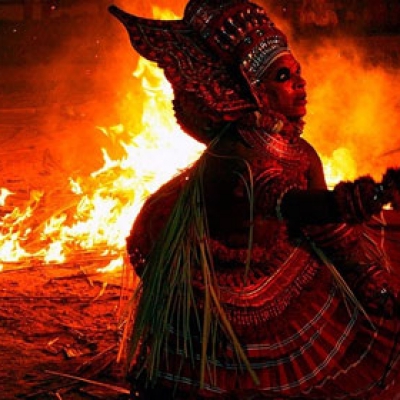
Theyyam Performance
Theyyam is a unique and vibrant dance form of Kerala. Kerala has more than 400 different kinds of Theyyam in which each one has its unique aspects. It is mainly a sacred ritual art form which is performed in order to worship the Hindu Goddess "Kali".
Theyyam Performance - Kerala
This popular art form is originated in the North Malabar regions of Kerala. Theyyam unfolds great stories of the state of Kerala. Theyyam is neither performed on a stage nor any such requirements are needed. This art form is mainly considered as the Dance of Gods. Hence, it is usually performed before the village shrine, groves, and in some joint-family houses as ancestor-worship with elaborate rites and rituals.
Theyyam is celebrated every year between the months of December and April at the temples in Kerala, especially Kannur district in North Kerala with much pomp and rigor. The Theyyam festival is a celebration of divinity and devotion which is attracted by national and international tourists, art enthusiasts, art photographers, as well as the local people.
Theyyam has its roots in the ancient Dravidian culture of South India and therefore it is a part of the ancient tribal culture of Kerala where tribal animism was once the most common form of worship. Hence, in Theyyam rituals, trees, plants, and animals are worshipped along with Hindu gods. Some rituals even involve some dangerous feat like blood sacrifices, fire walking etc.
Theyyam is also known as ‘Kaliyattam’ or ‘Thirayattam’. As it is a sacred ritual dance performed to worship the goddess Kali, it is known by the name Kaliyattam. As every thira or village performed this ritualistic art at the village temple known as kaavu, it earned the name Thirayattam.
The Theyyam performance is a perfect blend of dance, music and mime. The Theyyam represents a divine, mythological, or heroic character and is always performed by men. And the men themselves enact the female roles by wearing exotic makeup and colourful costumes. The Theyyam performer is called ‘Kolam’. Theyyam is considered as a god by the local people and they seek blessings from Theyyam. The costumes and makeup which are amazingly colourful and exciting are the main highlights of Theyyam. The makeup is often done by co-dancers and specialists.
The facial makeup is so intricate that it takes hours to finish. Theyyam wears a headgear that is made from tender coconut leaves. The facial makeup and the headgear vary from character to character. The crown (muti) is made from bamboo splices and wooden planks which are covered with color cloths, coconut leaves and flowers. Arm ornaments, breastplates, bangles, garland and other body decorations are also used in Theyyam.
Vellattam or Thottam is the first part of the Theyyam performance. It is performed with only a small red headdress and no proper make-up or any decorative costume is used during this occasion. Then the dancers are accompanied with drummers and they recite a particular ritual song, which describes the myths and legends of the deity of the shrine to be propitiated.
Folk musical instruments are also used at this time. The dancer returns to the green room, after finishing this primary ritualistic part of the chant. After a short interval, the performer reappears with elaborate costumes and makeup. The dancer comes in front of the shrine and gradually transforms into the particular deity of the shrine.
And then the dancer runs all around the shine and its courtyard and continues dancing there. At last, the dancer distributes turmeric powder as a symbol of blessing and also throws rice on the audience. Theyyam is believed to have some curative powers.